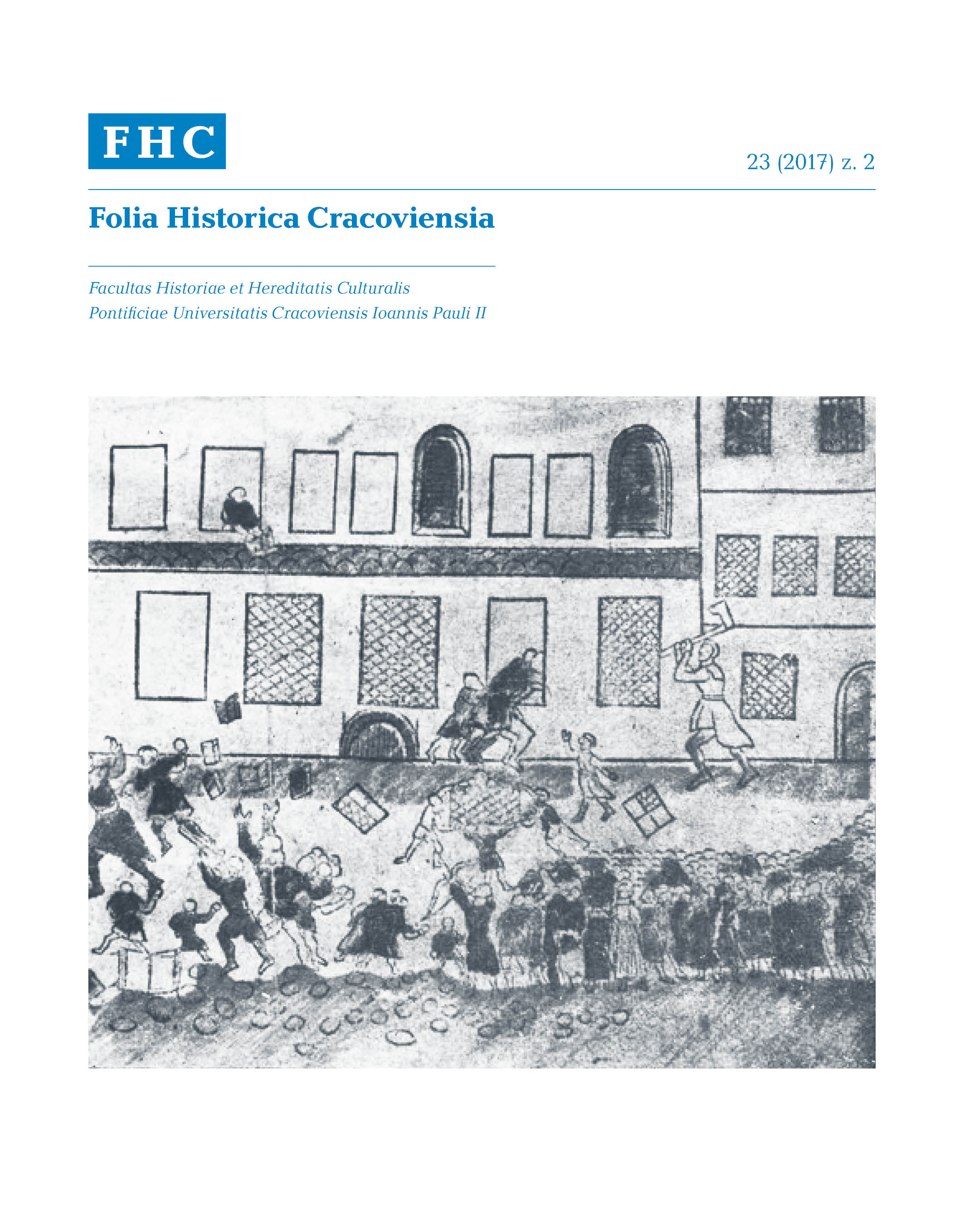Ambrogio Contarini i jego podróż na Wschód. Okoliczności nawiązania kontaktów dyplomatycznych przez Wenecję i Polskę z Persją w drugiej połowie XV w.
DOI:
https://doi.org/10.15633/fhc.2232Słowa kluczowe:
Persja, islam, Turcja osmańska, Republika Wenecka, późne krucjaty, papiestwo, Królestwo Polskie, Jagiellonowie, Ruś, TatarzyAbstrakt
Artykuł poświęcony jest mało znanemu w historiografii wątkowi dyplomatycznych kontaktów pomiędzy Europą chrześcijańską a Uzun Hassanem (1423-1478), władcą Persji. Stolicą jego państwa było, leżące obecnie w północno-zachodnim Iranie miasto Tabriz. Uzun Hassan wspierał militarnie przeciwników Turcji osmańskiej i dążył do nawiązania kontaktów dyplomatycznych z państwami chrześcijańskimi. Autor krótko przedstawił dzieje tych poselstw, których celem była zazwyczaj Wenecja i Rzym. W 1472 r. jedno z nich zawitało również do stolicy Królestwa Polskiego Krakowa. Poza krótkimi wzmiankami we współczesnych kronikach i dokumentach dyplomatycznych niewiele wiemy o szczegółach tych pierwszych politycznych kontaktów z Persją. Zasadnicza część artykułu odnosi się natomiast do niezwykle dobrze udokumentowanej źródłowo podróży na dwór Uzun Hassana w Tabriz weneckiego posła Ambrogio Contariniego. W dyplomatyczną podróż wyprawił się on z Wenecji w lutym 1474 r. Ponieważ Turcy w owym czasie blokowali przeprawę z Cypru do Azji Mniejszej wenecki poseł zdecydował się na podróż lądem poprzez Niemcy, Królestwo Polskie i Ruś. Niezwykle cenne są jego opisy mało znanych regionów leżących nad Dnieprem, w tym samego Kijowa. Szczegółowo opisał swoją pełną przygód podróż kierując się do Kaffy nad Morzem Czarnym. Stamtąd omijając posiadłości tureckie i góry Kaukazu, uniknąwszy wielu niebezpieczeństw Contarini przedostał się do Persji.Bibliografia
S. Auld, Renaissance Venice, Islam and Mahmud the Kurd. A metalworking enigma, London 2004.
F. Babinger, Mehmed the Conqueror and His Time, Princeton 1978.
K. Baczkowski, Callimaco e le ambascerie veneziane in Polonia negli anni 70 del XV secolo, „Zeszyty Naukowe Uniwersytetu Jagiellońskiego-Prace Historyczne” 110 (1994).
C. Baskins, The Bride of Trebizond. Turks and Turkomens on a Florentine Wedding Chest, circa 1460, "Muqarnas. An Annual on the Visual Cultures of the Islamic World" 29 (2012).
G. Berchet, La Repubblica di Venezia e la Persia, Torino 1865.
A. Bryer, Greeks and Türkmens. The Pontic Exception, "Dumbarton Oaks Papers" 29 (1975).
Cudzoziemcy o Polsce. Relacje i opinie, opr. J. Gintel, Kraków 1971.
J. Grygiel, Udział rycerstwa polskiego w walce z Turkami w czasach panowania Władysława Jagiełły i Zygmunta Luksemburskiego, "Zeszyty Naukowe Uniwersytetu jagiellońskiego. Prace Historyczne" 102 (1992).
R. Jaworski, Relacja Ambrogio Contariniego jako źródło do edukacji synów Kazimierza Jagielończyka, in: Z tradycji historii kultury i oświaty. Studia ofiarowane Jerzemu Kukulskiemu w siedemdziesiątą rocznicę urodzin i czterdziestą pracy naukowej, ed. M. Pindera, Piotrków Trybunalski 2007.
J. Jefferson, The Holy Wars of King Wladislas and Sultan Murad. The Ottoman-Christian Conflict from 1438-1444, Leiden 2012.
Joannis Dlugossi Annales seu cronicae incliti Regni Poloniae, vol. 12 (1462-1480), Kraków 2005.
Magyar diplomacziai emlékek Mátyás király korából 1458-1490, ed. I. Nagy, vol. 2, Budapest 1875.
D. Malipiero, Annali veneti dall'anno 1457 al 1500, vol. 1, Vieusseux 1843.
V. Minorsky, The Aq-Qoyunlu and Land Reforms, "Bulletin of the School of Oriental and African Studies, University of London" 17 (1955).
A.M. Piemontese, L'ambasciatore di Persia presso Federico da Montefeltro, Ludovico Bononiense O.F.M e il Cardinale Bessarione, "Miscellanea Bibliotecae Apostolicae Vaticanae" 11 (2004).
G. B. Ramusio, Navigazioni e viaggi, ed. M. Milanesi, vol. 3, Turin 1980.
G. Rota, Diplomatic Relations between Safavid Persia and the Republic of Venice. An Overview, in: The Turks, vol. 2, ed. H.C. Guzel, C.C. Oguz, O. Karatay, Ankara 2002.
H. Samsonowicz, Przemiany osi drożnych w Polsce późnego średniowiecza, "Przegląd Historyczny" 4 (1973).
K. M. Setton, The Papacy and the Levant (1204-1571), vol. 2, Philadelphia 1978.
J. Smołucha, Między Warną a Mohaczem. Zagrożenie tureckie w Polsce w świetle wybranych traktatów, „Studia Historyczne“ 38 (1995) no. 4.
J. Smołucha, Papiestwo a Polska w latach 1484-1526. Kontakty dyplomatyczne na tle zagrożenia tureckiego, Kraków 1999.
B. Stachoń, Polska wobec weneckich projektów użycia Persów i Tatarów przeciw Turcji w 2 poł. XV wieku, in: Prace historyczne wydane ku uczczeniu 50-lecia Akademickiego Koła Historyków Uniwersytetu Jana Kazimierza we Lwowie 1878-1928, Lwów 1929.
O.-H. Storz, Die persische Karte. Venezianisch-persische Beziehungen um 1500, Berlin 2009.
J. A. Wadowski, Kościoły Lubelskie na podstawie źródeł archiwalnych, Kraków 1907.
J.E. Woods, The Aqquyunlu. Clan, Confederation, Empire, Salt Lake City 1999.
Pobrania
Opublikowane
Numer
Dział
Licencja
Prawa autorskie (c) 2017 Janusz Smołucha

Praca jest udostępniana na licencji Creative Commons Attribution-NonCommercial-NoDerivatives 3.0 Unported License.
Autorzy publikujący w czasopiśmie udzielają jego wydawcy zgody o następującej treści:
- Autor zachowuje autorskie prawa majątkowe do utworu, a jednocześnie udziela wydawcy czasopisma zgody na jego pierwszą publikację w wersji drukowanej i wersji online na licencji Creative Commons Uznanie autorstwa 4.0 Międzynarodowe oraz zgody na wykonywanie opracowań, w tym przekładów.
- Autor ma możliwość udzielania zgody niewyłącznej na opublikowanie utworu w wersji, która ukazała się w czasopiśmie (np. zamieszczenia go w repozytorium instytucjonalnym lub opublikowania w książce), wraz z informacją o jego pierwszej publikacji w czasopiśmie.
- Autor może umieścić swój utwór online (np. w repozytorium instytucjonalnym lub na swojej stronie internetowej) jeszcze przed zgłoszeniem utworu do czasopisma.

